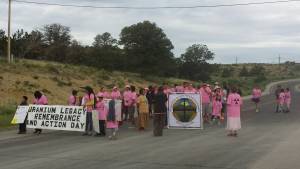New Mexico community still seeking full cleanup
By Rick Jones
July 16, 1979 is a day the Navajo Nation in New Mexico will never forget. An earthen dam gave way releasing 1,000 tons of solid radioactive mill waste and 90 million gallons of acidic and radioactive liquids into the Rio Puerco. From there, the waste traveled downstream across nine Navajo chapters as well as the community of Gallup. Residents described a “wave of green liquid” heading their way covering them as they headed toward home.
The Uranium Tailings Spill is still listed as the largest uranium spill in the United States. Recently the Red Water Pond Road Community Association hosted its annual commemoration near Church Rock.
“In 36 years, we’ve had three minor cleanups in the area but the contaminated waste is still here,” said Edith Hood, with the association. “We’ve been told by the Environmental Protection Agency that they are waiting on the Department of Energy and the Nuclear Regulatory Commission to complete its review of the area before additional cleanup work can be done.”
Among the organizations actively connected to the region is the Multicultural Alliance for a Safe Environment (MASE.) This grassroots initiative involves several groups working to remove the uranium contamination and prohibit future mines in the area. Participants include Acoma and Laguna Pueblos, community people in the affected area, Navajo Nation, the Post 71 Uranium workers and ranchers who have been affected by the uranium mining industry.
The Presbyterian Committee on the Self-Development of People awarded MASE a $15,000 grant to assist in cleanup and public awareness efforts.
“This community is facing an up-hill battle considering the government’s sensitivity concerning uranium contamination,” said Cynthia White, SDOP coordinator. “This battle is for clean air, land and water and it is also about maintaining spiritual harmony and balance in an indigenous community. SDOP is proud to assist the community in its struggle for a healthy existence on native land.”
The area, known as the San Juan Basin, has no basic rights to electricity or running water due to the radioactive contamination of the land, air and groundwater. According to MASE, there have been significant numbers of miscarriages and birth defects as well as confirmed cases of liver and pancreatic cancer.
“There are many with breathing problems, including children suffering from asthma and bronchial problems,” said Hood. “I have worked in one of the mines and have been through chemo treatments for lymphoma.”
Hood’s group conducts public awareness activity and has been successful at keeping old, abandoned mines from re-opening to this date.
![]() You may freely reuse and distribute this article in its entirety for non-commercial purposes in any medium. Please include author attribution, photography credits, and a link to the original article. This work is licensed under a Creative Commons Attribution-NonCommercial-NoDeratives 4.0 International License.
You may freely reuse and distribute this article in its entirety for non-commercial purposes in any medium. Please include author attribution, photography credits, and a link to the original article. This work is licensed under a Creative Commons Attribution-NonCommercial-NoDeratives 4.0 International License.
Categories: Advocacy & Social Justice
Tags: environment, environmental, grants, MASE, Native American, SDOP
